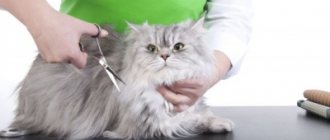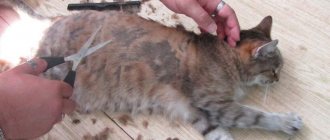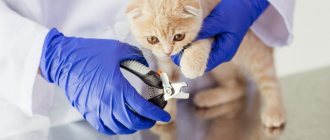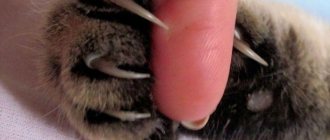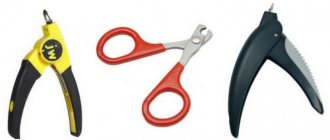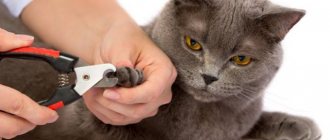Cat owners are rewarded with affection, purring and a great mood, but they also bear responsibility for the health and well-being of their pet. Owners are faced with an important question: how to trim a cat’s claws without harming them.
Without the skill, not everyone succeeds in pruning the first time - it is difficult to immobilize a pet, you only need to cut off the overgrown part so as not to harm it. The article discusses in detail common questions - how many claws does a cat have and how to trim them correctly, as well as why to cut them.
Which animals are not recommended for the procedure?
There is no need to trim the claws of a cat that roams freely outside. She needs her nails to climb trees, hunt and defend herself from other four-legged animals.
Also, the procedure is not performed on kittens under 1 month of age. Their claws are not yet formed. Early cutting negatively affects the structure of the nail plate and leads to delamination.
But already at 2 months the claws are strongly extended, and the kitten begins to scratch. At this time they can already be cut.
Nail trimming depending on breed
At what age are British cats neutered?
Veterinarians say that the condition of the nails and the rate of their growth directly depends on the specific breed of the animal. And this factor influences the cutting process. Persian cats often experience delamination of the horny area and rapid growth of claws. Therefore, experts advise carrying out the procedure for this breed several times a month. The condition of the nails is also affected by the age of the pet. In mature years, an abnormal growth of the claws sometimes occurs. Because of this, it is recommended to trim them only under the supervision of a specialist. Additionally, a change in diet may be prescribed to strengthen the nails.
Based on these features, it is worth considering the procedure based on the characteristics of the animal’s breed.
Claw clippers
Haircut for the sphinx
The Thai Sphynx's claws grow quite quickly. And the main feature is the frequency of the procedure. You will have to cut off the claws several times a month. The process consists of several steps:
you need to choose the right moment. It is best when the animal is a little tired and about to fall asleep. It is difficult for a pet in this state to actively resist; he will be relaxed. You need to handle it calmly, without sharp or loud sounds; a suitable place with good lighting is selected in advance. It is necessary to place everything that is required in the process there.
Of course, it is important to act carefully so as not to injure your paws. But just in case, it’s worth keeping hydrogen peroxide nearby to treat wounds; Sphinx sits on her owner's lap
Gently press on the pads of the paws so that the claws appear
In good lighting, the border where the vessels begin is clearly visible. Only white areas can be removed. Anything that has a pink tint should not be touched; At an angle of 90 degrees, a small part of the nail is removed with the selected tool.
Gently press on the pads of the paws so that the claws appear. In good lighting, the border where the vessels begin is clearly visible. Only white areas can be removed. Anything that has a pink tint should not be touched; At an angle of 90 degrees, a small part of the nail is removed with the selected tool.
Reference! If the plate begins to peel, you should carefully file it with a file and remove it.
If it was not possible to avoid injury and blood appears, it is recommended to apply a piece of cloth or cotton wool soaked in peroxide
If bleeding is severe, it is important to contact your veterinarian promptly.
Trimming a Brit's nails
And others
A British cat needs to have the procedure done every 3 weeks. You should also inspect the animal's claws. Each pet is individual and some representatives of the British breed may have slower nail growth. Therefore, trimming will need to be done once a month.
Owners of Scots are lucky in that representatives of this breed are intelligent. Therefore, problems with training to carry out hygienic procedures rarely arise. The claws of the Scots are quite transparent and the border between the blood vessels and dead areas is clearly visible. This makes the cutting process easier.
What tools can you use?
There are special nail clippers for trimming cat claws. It is not recommended to use nail scissors. They are designed for thin and flat nail plates of people. Such cutting tools lead to delamination.
There are several types of nail clippers:
- Blisters - resemble nail scissors, but have blades curved at the ends, designed for cat claws.
- Secateurs are equipped with a spring, which is located between the handles. As a rule, such models have a limiter. It allows you to cut only the desired length.
- Guillotines are similar to cigar scissors. The nail is placed in the hole at the end. When the handles are closed, the blade lowers and cuts the claw. The tool is suitable for cats with thick nail plates.
Each owner chooses the model that is convenient for him to use. The main thing is that it is made of high-quality materials and sharpened.
Additionally, you can buy an electric trimmer that allows you to quickly trim your nails. However, not all cats react calmly to it - the buzzing device scares the animals.
Important. When cutting, the blade of the guillotine nail clipper must move from bottom to top, otherwise the risk of crushing the nail increases. This is especially dangerous for kittens whose claw plates are not yet strong enough.
First aid for injuries
Even experienced owners may experience situations where the pruning procedure becomes stressful. This could be due to a huge number of factors, ranging from a dull instrument to a sharp sound outside the window that frightened the pet.
It is important to remain calm and clearly understand the algorithm of actions in the event of an injury.
Pulp trauma
If the pruning is done too short, there is a high risk of damaging a large number of blood vessels. In this case, heavy bleeding and sharp pain occur;
This is interesting: Why Blood Vessels Burst in the Eyes
It is the owner's job to stop the bleeding and calm the dog. Try to distract your pet. You should not shout at him, because the animal is in severe pain;
Using brilliant green, an alcohol solution of iodine, or other alcohol-containing antiseptics will only increase the pain. Therefore, many breeders prefer to treat open wounds with antiseptic powder.
You might find our article useful: Home veterinary first aid kit for dogs
This is important: If an injury occurs, and the first aid kit does not have the necessary medications, then experts advise stopping the bleeding with the help of flour.
Claw detonation
This situation arises in case of uncertain actions of the owner. Slow squeezing of the nail clipper by the owner in combination with a sharp jerk of the paw at the moment of manipulation can lead to disastrous results.
As a result, the claw becomes caught in the instrument and the skin and soft tissues rupture. The owner should:
- Remember that this is very painful for your four-legged pet. Therefore, he will try to break free and run away;
- The injured limb should be bandaged with gauze or a tourniquet in the metatarsal area; Raise the limb upward to stop bleeding;
- Apply cold to the injured paw. This could be an ice pack, food or fruit from the freezer;
- Open lesions should be treated with lidocaine. In its absence, this drug can be replaced with novocaine;
- If the wound is too large or the gap needs to be stitched, you should immediately seek help from a veterinarian.
This is important: before you remove frozen food from the freezer, place it in a bag and then wrap it in a towel or cloth. This will help avoid hypothermia. Also, you should not hold the cold on the injured limb for long to avoid frostbite.
The owner should remember that if an injury occurs, the dog must be left alone and not continue the nail trimming procedure for a period of 5-10 days.
How often is nail trimming done?
The frequency of haircuts depends on the individual characteristics of the cat. For some, it is enough to carry out the procedure once a month, for others – every 2-3 weeks.
As a rule, light-colored nails grow faster. And in cats that prefer active games, partial wear occurs naturally. To determine the exact timing, you just need to carefully observe your pet.
For your information. A cat needs to have its claws trimmed before an exhibition, competition or other important event.
Alternative Methods
If your cat categorically refuses to get a pedicure and it is inconvenient to take him to the veterinary clinic every month, you can consider alternative methods:
- Antitsapapki. Special overlays (caps) prevent damage to the furniture, but it is uncomfortable for the animal to walk, and the horny plates still grow and need to be cut off.
- Onychectomy or soft paw surgery. A difficult procedure for the animal, during which part of the cat’s fingers is taken away. Animals' paws become deformed, they lose coordination, and suffer from pain. Condemned by many veterinarians and breeders. In a number of countries the operation is prohibited.
Preparing for the first procedure
To trim a cat's claws with minimal stress, the animal is first accustomed to this procedure. It is better to start doing this in childhood. Kittens adapt to any changes more easily than adults.
For your information. There are cases where adult cats, accustomed to clinging with their claws while jumping, have fallen and been injured due to the fact that their nails were suddenly cut.
Preparations for grooming begin at a time when the cat is not doing anything (not playing, licking itself, eating or sleeping). They take her in their arms and stroke her affectionately.
Then they carefully move to the paws - they try to touch, lightly massage, imitate a haircut. At the same time, they talk to the pet and try to switch its attention to something interesting so that it does not break out.
As a rule, kittens do not like to have their paws touched, so the first 2-3 times they will get irritated and run away. But if you regularly repeat this exercise, the baby will get used to the manipulations. To reinforce the positive associations, he is given a treat at the end.
When the kitten begins to be calm about being touched, they begin to “rehearse” the haircut itself:
- put the pet in the desired position;
- take each paw in turn;
- examine the nails, press on the pads.
If the kitten tolerates all the actions, he is sincerely praised.
Then the pet is introduced to the nail clipper. It is important to show that the tool does not pose any danger. After the animal begins to treat him calmly, you can cut the kitten’s claws for real.
The need for nail clippers
Naturally, claws wear down during fairly long walks on concrete or asphalt. However, this is often not enough. Considerable attention should be paid to the claws on the lateral or dewclaws. The dogs don't reach the ground, so they don't wear off. As the dewclaws grow, they sometimes grow into the skin, causing pain if they are allowed to grow excessively. Under any circumstances, attentive dog owners have a tool that can help keep their pet's paws and claws in perfect order. This is a nail clipper.
Step-by-step instruction
A cat's claws consist of a keratinized layer, inside of which there is a pulp - a collection of nerve endings and blood vessels. When trimming, it is important not to touch a sensitive area, otherwise it will be very painful for your pet and blood will come from the wound.
In cats with light-colored claws, the pulp is clearly visible - it looks like a pink, crescent-shaped area. You can point your paw at a bright light or use a flashlight - the picture will be clearer.
It is more difficult to trim the claws of cats with dark pigmentation - you will have to act blindly. In this case, carefully cut off 1-2 mm at a time until the color inside becomes a little lighter - this is the beginning of the pulp.
For your information. Before cutting, remove the hair between the pads so that it does not interfere.
Nail trimming begins when the cat is calm, relaxed and ready to communicate. At this point, the owner should disinfect his hands and nail clippers, prepare cotton pads and antiseptic in case of injury.
Step-by-step instructions for trimming nails at home:
- The owner takes a comfortable position, puts the cat on his lap with his back to himself or lays him on his back. Particularly mobile pets can be wrapped in a terry towel.
- He takes the paw in his hand and presses on the pad to expose the claw.
- He brings the nail clipper to his paw. If the cat does not show concern, clicks it. In case of anxiety, he strokes and calms the pet, after which he repeats the manipulation.
- Now quickly and confidently sets the nail cutter 1-2 mm to the pulp and trims the claw so that the edge remains sharp. If you cut the platinum at the wrong angle, you will be more likely to hit the pulp.
- At the end, the cuts are rounded off with a nail file, giving a natural shape. In the future, you will be able to trim your claws less frequently if you regularly trim the overgrown areas.
If you trim your cat's nails correctly, your cat will not experience any discomfort. In fact, many animals struggle and hiss not because of pain, but because they are scared.
In order not to overwork the cat, the haircut is carried out in several passes. For example, one paw is treated daily.
First aid for injuries
Most dogs are very worried before trimming their nails, even if they have not experienced negative emotions about this before. One option is relaxation medications. As a rule, sedatives are produced from herbs and weaken nervous excitability, all this gives exactly the effect that is required for a cosmetic procedure. Then prepare special powder, powder or wipes with hemostatic properties. If you cut the claw too deeply, several dozen important vessels will be damaged. Quite often, injuries are accompanied by severe bleeding, and this initiates mutual panic for both dog and owner.
It is important to know that under no circumstances should you treat a damaged claw with the following drugs:
iodine;- fucorcin;
- hydrogen peroxide;
- dimexide;
- alcohol;
- brilliant green;
- vodka.
If you don’t have special powder or baby powder nearby, then ordinary food flour will do. All kinds of cauterizing and alcohol-containing solutions will only increase the pain!
Another rather difficult injury is claw tearing. Most often, this happens if you squeeze the nail clippers for a long time, and the dog suddenly jerks its paw. The secured claw remains in the clamp, and the soft tissue and skin are torn.
The first thing to remember is that this is very painful for the dog! Get ready for your tailed friend to whine loudly and try to run away. Operate quickly enough and without panicking:
- Constantly talk to the dog, console him, do everything in order to distract him from what is happening.
- Intercept the wounded paw with a piece of gauze in the area of the wrist (metatarsus).
- Tighten and secure the gauze thoroughly, while it is recommended to raise the limb as high as possible. Apply cold to the injured paw - ice, a piece of minced meat, frozen vegetables taken from the freezer. Wrap the compress in cotton cloth and cellophane in advance. Cold can help stop blood flow and moderate the pain to some extent.
- Carefully examine the wound, and if there are open tissue tears, fill them with novocaine or lidocaine.
What to do if the animal is not given
To trim the claws of cats that categorically refuse this procedure, they use fixing overalls. They provide access to all limbs, but do not allow the pet to move freely.
At first, it is advisable to carry out the haircut with an assistant who will hold the animal. If the cat meows loudly and struggles, take a break. Let her rest and calm down for a while, then you can try again.
Important. You should not swear or shout at a cat if it resists while trimming its claws. Aggression from the owner will only frighten her. In the future, the pet will try by all means to avoid the unpleasant procedure.
First aid for injuries
Most dogs are very worried before trimming their nails , even if they have not experienced negative emotions about this before. One option is relaxation medications. As a rule, sedatives are produced from herbs and weaken nervous excitability, all this gives exactly the effect that is required for a cosmetic procedure. Then prepare special powder, powder or wipes with hemostatic properties. If you cut the claw too deeply, several dozen important vessels will be damaged. Quite often, injuries are accompanied by severe bleeding, and this initiates mutual panic for both dog and owner.
It is important to know that under no circumstances should you treat a damaged claw with the following drugs:
iodine;- fucorcin;
- hydrogen peroxide;
- dimexide;
- alcohol;
- brilliant green;
- vodka.
If you don’t have special powder or baby powder nearby, then ordinary food flour will do. All kinds of cauterizing and alcohol-containing solutions will only increase the pain!
Another rather difficult injury is claw tearing . Most often, this happens if you squeeze the nail clippers for a long time, and the dog suddenly jerks its paw. The secured claw remains in the clamp, and the soft tissue and skin are torn.
The first thing to remember is that this is very painful for the dog! Get ready for your tailed friend to whine loudly and try to run away. Operate quickly enough and without panicking:
- Constantly talk to the dog, console him, do everything in order to distract him from what is happening.
- Intercept the wounded paw with a piece of gauze in the area of the wrist (metatarsus).
- Tighten and secure the gauze thoroughly, while it is recommended to raise the limb as high as possible. Apply cold to the injured paw - ice, a piece of minced meat, frozen vegetables taken from the freezer. Wrap the compress in cotton cloth and cellophane in advance. Cold can help stop blood flow and moderate the pain to some extent.
- Carefully examine the wound, and if there are open tissue tears, fill them with novocaine or lidocaine.
For what?
Is it necessary to trim a dog’s nails, because many dogs grind their nails down themselves during long walks on the asphalt. But not all dogs have their nails worn down when walking on a hard surface. And the fifth claws do not touch the ground at all and generally cannot grind off on their own
At first glance, overgrown nails may not seem like such a big deal, but there are still many important reasons why they should be trimmed.
Why cut:
- Long claws can curl inward and, growing even larger, dig into the animal’s fingertips, causing severe pain.
- Overgrown claws tend to crack and break. And, if the claw gets too caught on something, it can break anywhere, even near the base.
- Due to long nails, the dog cannot place its paw straight and keep it in a ball. Toes become twisted or curved unnaturally, which is especially harmful for puppies, as this can lead to deformation of joints and ligaments.
- The animal's balance is disturbed. The dog may skid to the side when running, and on a smooth surface it may slip and fall.
- Overgrown claws can be dangerous not only for the dog, but also for its owners. The dog may accidentally injure the owner with them or tear his clothes.
- For show dogs, overgrown claws are a serious fault for which their score in the ring is greatly reduced.
Therefore, if you do not want unnecessary problems for either your pet or yourself, you need to monitor the condition of its claws and trim them regularly.
Consequences of owner laziness:

